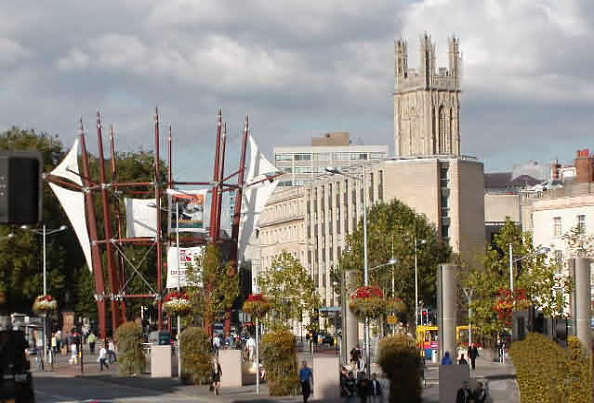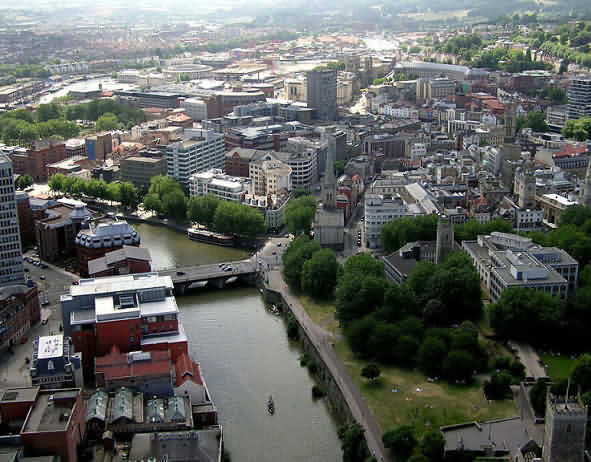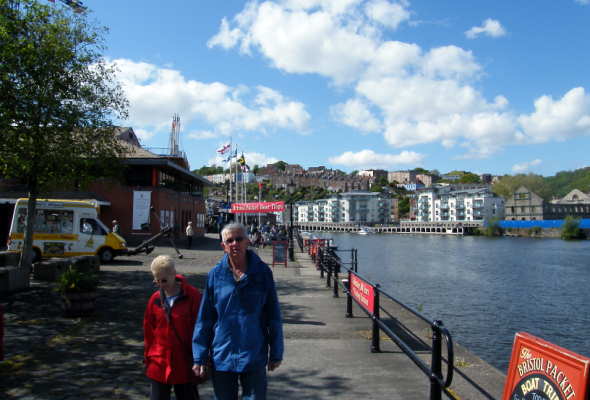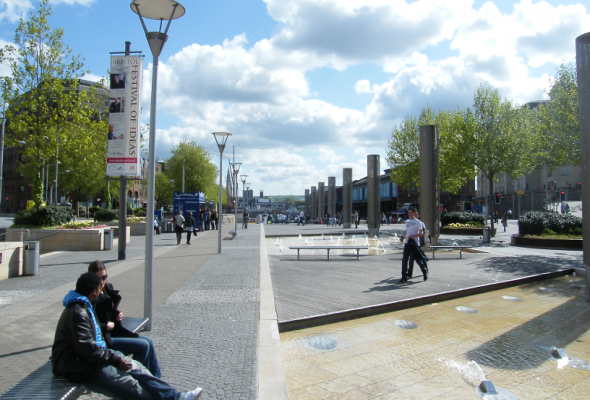| Check Out Lastminute on Accommodation |
The Local Time is Saturday, 27-Jul-2024 11:28:33 CEST
Historical Bristol |
|
|||
| YOU ARE HERE: Main Home Page > Places to Visit > Bristol Home > Historical Bristol | E-mail This Page |
|
|
 |
|
 Centre of City of Bristol  Bristol on the River Avon  Harbourside  Fountains in Bristol City Centre Map of Bristol area - obtain driving directions |
||||||||||||||||||||||||||||||||||||||||||||||||||||||||
|
||||||||||||||||||||||||||||||||||||||||||||||||||||||||
|
||||||||||||||||||||||||||||||||||||||||||||||||||||||||
|
Bristol is situated in the south west of England and accessible by air, train and road. It is reached by the motorway system, north - south M5, east - west M4. A vibrant, cosmopolitan Port and City with a long and varied history and with connections to the Wine Trade, Tobacco, Car Manufacture, Chocolate, Slavery, Press Gangs, Piracy and John Wesley's Chapel. See also origins of Bristol University. Once a major port rivalling Liverpool and London in importance. It was developed as a port in Saxon time and was known as Brigstow, sited at the junction of the rivers Severn and Frome it has a illustrious history. John Cabot sailed from here to find a passage to Italy, lost his way and discovered North America. John Cabot born 1450 died 1498 (exact dates not known) he was Italian born, he sought funding for his explorations in Italy was unable to do so and went on to receive financial support in England . It has a historic past that gives the visitor much to see and includes the superb Bristol Zoo Gardens. The zoo is dedicated to conservation, it opened in 1836 and is known to be the oldest zoo in the world outside of a capital city. For more information see - Bristol Zoo. Bristol Wine TradeThe oldest of the wine importers now still in existence is Averys Wines. With a history that goes back to 1793 Averys continue to import fine wines and trade just a short distance from their original premises. Now at Culver Street, it is possible to visit historic cellars with their vaulted ceilings and see the bottling lines and blending tanks that were once housed there. It is believed that the Avery family were related to the 17th century pirate Henry Avery who was based in Madagascar for his nefarious activities but was not believed to be connected with the wine trade. He was known to be ruthless and fearless, he was born in 1653 in Plymouth and captained a ship called “Fancy”, in 1696 some of his crew were captured and executed but Henry Avery escaped capture and eluded the authorities for the remainder of his life, his date of death is unknown, it is possible that he returned to England under an alias. The Tobacco TradeTobacco, believed to have been introduced into England in 1565 and grown in the Colonies of the Caribbean and North America . By the 1670s a large part of Bristol based ships were used in the import of tobacco and tobacconists shops were established in the city. Samuel Watkins and Henry Wills formed a partnership in 1786 and founded the Wills Tobacco Manufacturing Company. The Wills family were generous benefactors to many Bristol institutions including the University, City Museum and Art Gallery. Although Sir Walter Raleigh is accredited with the introduction of tobacco to England, it was already being used in France and Spain, he was mainly responsible for the acceptance of smoking in the royal court. The practice of smoking goes back into the prehistory period, traces of nicotine have been found in human remains dating back to those times. Smoking also has sacred origins in the Americas. |
||||||||||||||||||||||||||||||||||||||||||||||||||||||||
Car Making - Great Britain's most exclusive car manufacturerBristol is also the home of the luxury car manufacturer Bristol Cars, now car making for more than 62 years the company continues to thrive. It is not possible to visit the factory to see vehicles being built but for those who wish when visiting London people would be most welcome to call in at their showrooms whether interested in buying or not. Bristol Car show rooms - Bristol Cars Ltd, 368 - 370, Kensington High Street. London W14 8NL Tel: 0207 603 5554. |
||||||||||||||||||||||||||||||||||||||||||||||||||||||||
|
||||||||||||||||||||||||||||||||||||||||||||||||||||||||
ChocolateIn the 18th century Bristol was the principal British port for trade with the American colonies and the West Indies. Bristol ports involvement with the slave trade meant that following the transport of slaves that ships returned to Bristol carrying amongst other goods, Cocoa which lead to the making of chocolate. A pioneer in chocolate making was Joseph Fry, born in Wiltshire in 1728 and like the Cadbury family was a Quaker. He trained as a doctor he was a strong believer in the health qualities of cocoa. After starting up business as an apothecary he founded a chocolate factory in Bristol. His entrepreneurial spirit led him into the manufacture of soap and of china and book publishing . Following his death in 1787 the chocolate business was taken over by his grandsons, Joseph, Francis and Richard. Following further expansion of the business over the succeeding years it was decided in 1919 to merge with Cadbury Brothers. Their factory at Keynsham is due to close in 2010. Slave TradeThe two main centres in England for this trade was Liverpool and Bristol. The import and export trades to the Caribbean provided the opportunity to transport the human cargoes to America. Some slaves were retained to work in England. A leading force in the abolition of slavery was William Wilberforce, a Yorkshire man, he headed a campaign to put an end to this inhuman practice. Born in 1759 at Kingston on Hull he spent his lifetime seeking justice for these unfortunate people. The slave trade act was passed in 1807 and this lead to the Slavery Abolition act of 1833, the same year as his death. He was buried in Westminster Abbey. Press GangsCaptains of ships were responsible for the fitting out of the vessel for sea and to get their ships manned by fair means or foul ,thus the creation of pressgangs. Individuals were duped into going into certain locations and were either knocked unconscious or induced into a drunken state. In Bristol a pub known as the Hole in the Wall was a favourite place for press gangs . Still to be seen today is the small glass observation point used by the gangs. They were able to view their intended victims as they approached. Once rendered incapable the victim was carried or dragged aboard the vessel requiring crew. When at sea they had no chance of escape from their captors. Pirates and PrivateersWalking along Bristol’s ancient harbour, it's easy to imagine the tall ships with their sails whipping in the wind and the shouts and cries of sailors preparing to head out to sea. Bristol’s strong links with the ocean, and its key role in the profitable trade of slavery and tobacco, inevitably lead to the city’s involvement with piracy. Laws at the time stated that piracy was illegal - however the practice of privateering was not. Privateers were meant to have a 'letter of Marque' from their government allowing them to attack and steal from merchant ships of certain countries. Another pirate with Bristolian links was Bartholomew Roberts, who roamed the seas in the 18th century. He sailed from Bristol on merchant ships and was forced to join a band of pirates after his own ship was captured. He soon earned respect onboard and eventually became captain of the ship, and went on to become the most successful pirate in history, capturing 456 vessels in four years. He was killed in a battle against HMS Swallow, which had been specially commissioned to capture pirates. He was granted his dying wish to be buried at sea so his body would never be captured.
John Wesley’s Chapel, The New RoomThis place of history is located at 36 The Horsehair, Broadmead, Bristol. The New Room is the oldest Methodist building in the world and can be seen as it was in the 18th century. The foundation stone was laid by John Wesley on the 12th of May 1739, with its original pulpit where Wesley preached, looking along the chapel, it is easy to imagine the impact his words would have on the congregation, visitors can stand on the spot that this great orator once stood. In the preachers rooms above the chapel is a museum, in this , the story of John and Charles Wesley can be learned. See John Wesley’s preaching robe, and other personal effects. Bristol UniversityWith its origins in 1876 it was a university college until 1909 when it became the University of Bristol. It was in June 1874 that a meeting took place in Bristol’s Victoria Room’s and it was after gaining the support of Albert Fry and Lewis Fry (of Fry’s Chocolate ) that the instigators of establishing such a place of learning, John Percival Headmaster of Clifton College and Benjamin Jowett Master of Balliol College Oxford who not only gave support philosophically but also financially. From these beginnings the university now organises its academic affairs in 34 departments and 15 research centres. Situated in a lively part of the city but not a campus university it is convenient to the city’s amenities. For details of open days and events for the public to visit telephone 0117 928 9000 |
||||||||||||||||||||||||||||||||||||||||||||||||||||||||
|
||||||||||||||||||||||||||||||||||||||||||||||||||||||||
| BACK TO TOP | ||||||||||||||||||||||||||||||||||||||||||||||||||||||||
Historical Bristol | ||||||||||||||||||||||||||||||||||||||||||||||||||||||||
| This page last modified Friday, 12-Mar-2021 15:07:05 CET | ||||||||||||||||||||||||||||||||||||||||||||||||||||||||






